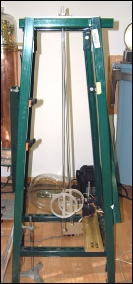
Precision Horology

DOUBLE PENDULUM CLOCK Q3

After considerable thought as to where I wanted to go next, I had some ideas for a double pendulum clock that were not fully formed but seemed to me were interesting enough to pursue. Double pendulum clocks have been made at least since Janvier and Breguet constructed several examples in the early 19th Century. Antide Janvier made at least one floor standing regulator that utilized two pendulums and Breguet made at least 3 quite famous clocks. The principle of resonance between a pair of pendulums has been known at least since Christian Huygens in the 17th Century. There have been a number of complicated and quite wonderful modern double pendulum clocks created within the past 10 years or so by Stephen Gagneaux, Beat Haldimann, Buchanan and most
recently by David Walter. My double pendulum clock Q3 doesn’t have the mechanical sophistication that these more modern two pendulum clocks have but it is unique and interesting in many other ways, particularly in the way the pendulums receive their impulse and the precision with which that impulse is given.
When two pendulums are in resonance, they will oscillate 180 degrees out of phase
which creates a stabilizing effect on the clock’s rate. In addition, it helps reduce
the effects of vibration on the clock in general. In order for two pendulums to oscillate
in this manner, they have to be coupled in some way. For example, pendulum clocks
mounted on the same wall will oscillate in unison – coupled through the common wall
-
Generally, double pendulum clocks utilize a common mounting for the pendulum suspensions. This effectively couples the two pendulums creating the condition for resonance with a 180 degree phase shift.
The pendulums and knife edge suspensions in the test stand.
The mechanically finished movement being tested in the purpose made mahogany case. The pendulums are running 180 degrees out of phase. The dial movements have not yet been finished.

(RIGHT) The 18C Breguet clock case I used as a model for Q3.
This is a fairly large file and you should have at least a dsl connection
A work in progress